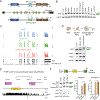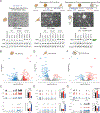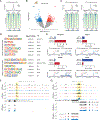Alternative splicing of a chromatin modifier alters the transcriptional regulatory programs of stem cell maintenance and neuronal differentiation
- PMID: 38701759
- PMCID: PMC11126784
- DOI: 10.1016/j.stem.2024.04.001
Alternative splicing of a chromatin modifier alters the transcriptional regulatory programs of stem cell maintenance and neuronal differentiation
Abstract
Development of embryonic stem cells (ESCs) into neurons requires intricate regulation of transcription, splicing, and translation, but how these processes interconnect is not understood. We found that polypyrimidine tract binding protein 1 (PTBP1) controls splicing of DPF2, a subunit of BRG1/BRM-associated factor (BAF) chromatin remodeling complexes. Dpf2 exon 7 splicing is inhibited by PTBP1 to produce the DPF2-S isoform early in development. During neuronal differentiation, loss of PTBP1 allows exon 7 inclusion and DPF2-L expression. Different cellular phenotypes and gene expression programs were induced by these alternative DPF2 isoforms. We identified chromatin binding sites enriched for each DPF2 isoform, as well as sites bound by both. In ESC, DPF2-S preferential sites were bound by pluripotency factors. In neuronal progenitors, DPF2-S sites were bound by nuclear factor I (NFI), while DPF2-L sites were bound by CCCTC-binding factor (CTCF). DPF2-S sites exhibited enhancer modifications, while DPF2-L sites showed promoter modifications. Thus, alternative splicing redirects BAF complex targeting to impact chromatin organization during neuronal development.
Keywords: BAF complex; DPF2; PTBP1; alternative splicing; chromatin remodeling; embryonic stem cell; histone modification; mammalian SWI/SNF complex; neuronal differentiation; transcription.
Copyright © 2024 The Author(s). Published by Elsevier Inc. All rights reserved.
Conflict of interest statement
Declaration of interests The authors declare no competing interests.
Figures







References
Publication types
MeSH terms
Substances
Grants and funding
LinkOut - more resources
Full Text Sources
Molecular Biology Databases
Research Materials
Miscellaneous

